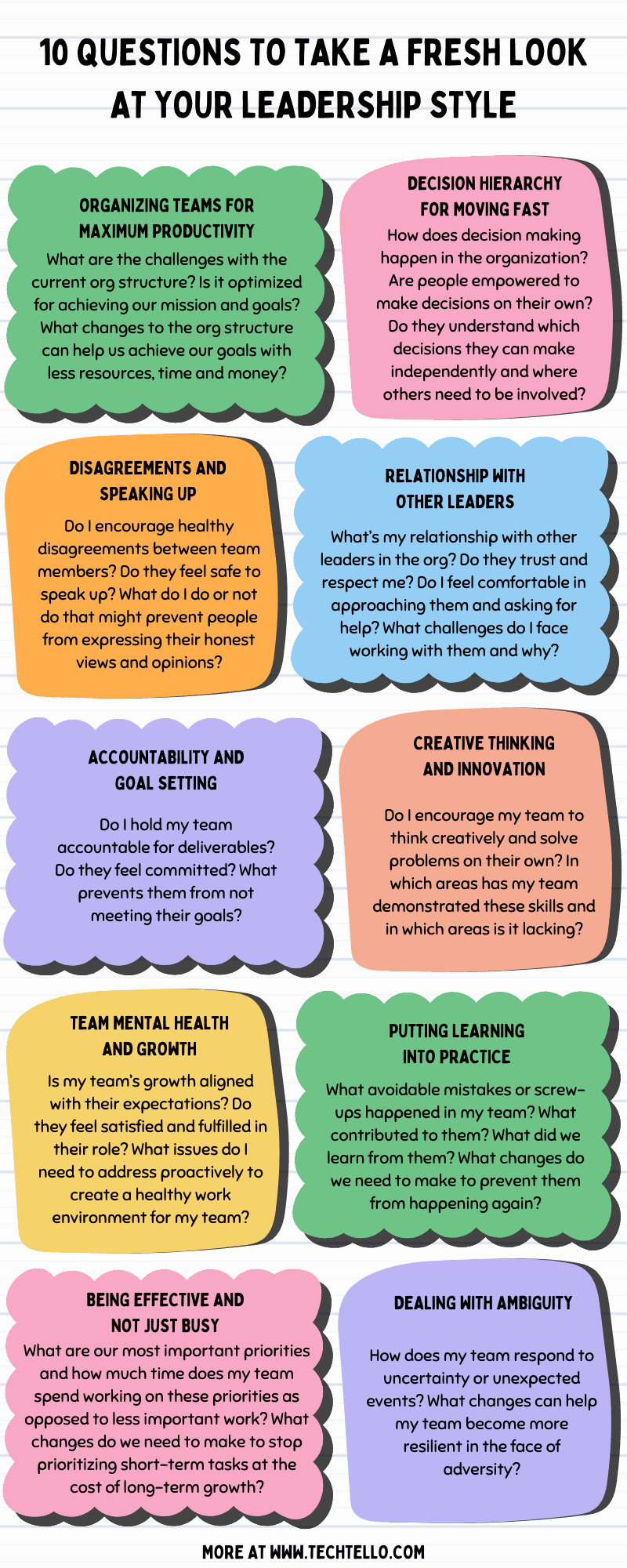Ask These 10 Questions to Take a Fresh Look at Your Leadership Style

Higher up in the hierarchy you go, the bigger are the problems you need to face. Not only do you need to deal with complexity, what others expect from you goes up as well.
It’s also lonely at the top, which means there’s less feedback on how you’re doing and what you can do to improve. This is where most leaders go wrong. Instead of paying attention to their leadership style, they pack their schedules with meetings and run with a long list of things to do.
Not knowing how they come across to others keeps them ignorant—ignorant of their behavior, their people and their competence.
- Leaders who are ignorant of their behavior do not pay attention to the impact their actions have on others. Without being careful about the message they convey to their teams, they end up promoting unhealthy behaviors and practices.
- Leaders who are ignorant of their people do not take time to connect at a personal level. Without understanding each individual’s strengths, motivations, and desires, they miss business targets and fail to grow their teams.
- Leaders who are ignorant of the gaps in their knowledge and skills refuse to seek other people’s opinions, blindly stick to their faulty decisions, and ignore opportunities to build skills and grow their talents.
It doesn’t matter how smart, capable or intelligent you are. Navigating the challenges and unknowns as a leader requires a basic skill—curiosity. You’ve to be open to the idea of improvement. You have to differentiate between behaviors that push your team to the ground and those that lift them up.
Not knowing something as a leader is not a massive disadvantage. Not being curious and open about what you don’t know is. You have to see your blind spots that can get in the way of your success.
A great way to do this is a quarterly self-reflection exercise. Asking good questions opens the door to new ideas and possibilities. It surfaces problems, helps you stay in touch with reality and gives you insights into the changes you need to make to be effective in your role.
Answer these 10 questions to take a fresh look at your leadership style and identify changes necessary to be successful in your role:
Organizing teams for maximum productivity
What are the challenges with the current org structure? Is it optimized for achieving our mission and goals? What changes to the org structure can help us achieve our goals with less resources, time and money?
The structure of your organization—different functions that exist and teams within each function—can have a significant impact on your outcomes. Carefully designing an org aligned with the strategy of your organization requires purposefully examining the gaps that exist and taking proactive steps to reduce those gaps.
You need to organize people into groups that make it easy to communicate, collaborate and get work done. Take a closer look at your current org structure:
- Is everyone placed in positions to achieve maximum efficiency?
- Can you spot talent gaps in specific teams or functions?
- Are you missing teams or functions that weren’t part of your strategy earlier, but are now essential to your growth?
An org hierarchy that worked for you in the past may not work in the future. Adapt it based on the future needs, don’t be constrained by the past.
Decision hierarchy for moving fast
How does decision making happen in the organization? Are people empowered to make decisions on their own? Do they understand which decisions they can make independently and where others need to be involved?
When leaders in an organization make mole whacking their job, they have a long list of important things to do, but instead of making progress on the difficult parts of their job that will move their teams and their organization forward, they are weighed down by trivial decisions.
Once mole whacking becomes a habit, leaders are involved in every decision, in every problem. Getting involved in every small detail, in every small problem is no joke. It takes a lot of energy and often leads to decision fatigue, exhaustion, and burnout.
There’s another problem. Exhaustion from attending to surface-level problems leaves less mental space to think about hard problems.
Reed Hastings writes in No Rule Rules “Lead with context, not control. When you give low-level employees access to information that is generally reserved for high-level executives, they get more done on their own. They work faster without stopping to ask for information and approval. They make better decisions without needing input from the top.”
Instead of being caught up in mole whacking, leaders need to do grub hunting—focus on the roots instead of leaf-level problems and decisions. This can happen only when leaders shift from control to context. When they give clarity to their people on the decisions they can own independently from the ones that require their control.
A leader’s job in any organization isn’t to tell people what to do, be involved in every problem, or deliver 100% perfect outcomes. Their job is to enable people to use their knowledge to make their own decisions, motivate them to build the skills necessary to feel confident, and use their own time effectively to look into the future and solve hard problems.
Disagreements and speaking up
Do I encourage healthy disagreements between team members? Do they feel safe to speak up? What do I do or not do that might prevent people from expressing their honest views and opinions?
Your job as a leader isn’t to have all the answers. It is to inspire creativity and curiosity in your team so that they can think on their own and find their own answers.
Doing this is very difficult because unlike other areas where people can just rely on your words, enabling it requires matching words with your actions. You have to walk the talk. You can’t expect people to feel safe to speak up when you don’t demonstrate what you preach in your own actions.
To build a psychologically safe environment, pay attention to your behavior:
- How do you react to mistakes?
- How do you behave when someone disagrees with you?
- Do you acknowledge the gaps in your knowledge by saying “I don’t know” or do you put on a show?
Prioritize finding the right answers above the need to appear smart or show off your brilliance. Don’t be afraid to admit when you don’t know something or when you might be wrong. Doing this will encourage your team to voice their opinion.
Relationship with other leaders
What’s my relationship with other leaders in the org? Do they trust and respect me? Do I feel comfortable in approaching them and asking for help? What challenges do I face working with them and why?
When leaders in an organization work together and co-operate, it’s easier to drive changes and get things done. Without support from other leaders, any change you try to make will be met with resistance.
You have to take the initiative to build this relationship. You have to make them see that you’re on their team and not against them.
A great way to do this is to show curiosity about their work, lend support when they need it and take time to understand what puts them off or makes them tick.
A strong leadership team with the attitude to work together and help each other succeed is the foundation of a strong organization. Be the leader that builds it.
Accountability and goal setting
Do I hold my team accountable for deliverables? Do they feel committed? What prevents them from not meeting their goals?
Leaders that do not set expectations or communicate goals clearly make it hard for their teams to feel accountable for their actions. Without a clear goal in sight, it’s easy to get distracted and waste time and energy chasing wrong targets and doing meaningless work.
People can’t feel committed when leaders do not have clarity on the strategic mission of their organization or fail to communicate it with their teams. Clarity precedes accountability. You have to define the success criteria, communicate it to your team and repeat it often to ensure they get it right—clarity will allow them to measure how they’re doing, find ways to course correct, put changes in place to get back on track and do the right thing.
You also need to empower them—when they know the desired end state and have the right tools and resources at their disposal, they will feel in control and will be willing to do what it takes to succeed and get work done.
To do this, think about:
- What’s the mission of my org?
- What role does my team play in fulfilling it?
- What level of clarity do they have?
- What information can help them do better and succeed in their goals.
Placing demands on people won’t make them accountable. Make them part of your mission and give them the necessary information to enable them to perform at their highest level.
Creative thinking and innovation
Do I encourage my team to think creatively and solve problems on their own? In which areas has my team demonstrated these skills and in which areas is it lacking?
When posed with a challenging problem or when dealing with uncertainty, your default reaction may be to play safe—doing things the way they have always been done, reject unpopular ideas and resist anything that appears risky.
But not letting your team step outside their comfort zone limits innovation and growth. Your team can’t think creatively when your discussions start with boundaries and constraints. They can’t innovate when all their time is spent preserving the status quo.
New ideas are risky, but they’re also necessary for innovation. You must be willing to take chances. You must encourage your team to explore the uncharted territory, build cross disciplinary thinking and use their knowledge and experience to find creative ways to solve hard problems.
To build creative thinking skills in your organization:
- Enable your team to find their own solutions using the Socratic questioning method.
- Encourage them to connect beyond team boundaries and learn how other teams and functions work.
- Expand their mental models by acquiring knowledge from multiple domains and disciplines.
- Use experimentation as a strategy to test their ideas and validate their thinking.
Don’t rely on conventional wisdom to determine how things must be done. Challenge the status quo, encourage new ideas and creative ways to solve problems.
Team mental health and growth
Is my team’s growth aligned with their expectations? Do they feel satisfied and fulfilled in their role? What issues do I need to address proactively to create a healthy work environment for my team?
In workplaces, burnout has become synonymous with work overload. But Michael Leiter, a Nova Scotia-based organizational psychologist, and the author of The Truth About Burnout says “The biggest misconception about burnout is that it’s the same as exhaustion. People use burnout as a synonym for tired, and they’re missing the point that there’s a world of difference between those two states.”
Without a proper understanding of burnout, the natural response from many leaders and managers is to encourage well-being within their teams by promoting vacation time, taking breaks between work, doing walk-and-talk audio calls instead of video calls to deal with zoom fatigue, and even asking people to have no meeting days.
These are all super useful techniques to deal with the problems of work related exhaustion, but by themselves they are not sufficient to solve the problem of burnout at work. That’s because work overload is just one of the causes of burnout.
Christina Maslach, a professor of psychology at the University of California, Berkeley, developed Maslach Burnout Inventory (MBI) to define and measure burnout. According to MBI, there are three dimensions of burnout:
- Feelings of exhaustion.
- Feelings of cynicism and negativity towards the job.
- Feeling ineffective at the job.
Employees who don’t feel engaged at work, who lack a sense of progress, who feel disconnected from their team and their organization, who don’t find a sense of purpose and meaning in their work, and those who feel ineffective in their job are at equal risk for burnout. A sense of progress, purpose and belonging is crucial to mitigate burnout and promote a healthy work environment for your employees.
Putting learning into practice
What avoidable mistakes or screw-ups happened in my team? What contributed to them? What did we learn from them? What changes do we need to make to prevent them from happening again?
As a leader, not only will you make mistakes, but your team will do so too. These mistakes can either be frowned upon, disregarded and considered bad or they can be treated as valuable sources with great learning lessons for you and your team.
Shaming people for making mistakes or telling them to avoid mistakes at all costs creates a toxic environment where employees act out of fear and worry excessively about losing credibility and damaging their reputation.
You don’t want your employees to act carelessly, but you don’t want them to be too careful either. Give permission to your employees to feel disappointed when things don’t go as expected, but don’t let such disappointments refrain them from reaching for their goals.
Be strategic about embracing mistakes:
- If it’s an avoidable mistake, discuss what led to the mistake, what did they learn from it and how they could have avoided it.
- If it was an unavoidable mistake, discuss learning lessons and the next steps.
Leaders who treat mistakes as unnecessary evil make a costly mistake—they fail to see what the mistake is trying to teach them and what they can do to move forward.
Being effective and not just busy
What are our most important priorities and how much time does my team spend working on these priorities as opposed to less important work? What changes do we need to make to stop prioritizing short-term tasks at the cost of long-term growth?
Teams that are constantly involved in solving urgent issues—putting out fires, handling a customer complaint, delayed delivery etc—react to what comes their way instead of consciously spending time on things that are crucial for an organization’s growth in the long term.
Reacting to urgent tasks while pushing important work aside makes them solve short term problems at the cost of more future oriented, forward looking activities. More and more urgent issues keep cropping up which wastes everyone’s time and energy.
Effective leaders are very conscious of how and where their team spends their time. They’re highly proactive about strategic thinking, planning and reducing time wasting urgent activities.
Aligning their team’s time and energy with the future goals of the organization reduces urgent issues, pushes the organization forward and makes employees feel happy and motivated.
To do this:
- Help your team adopt Eisenhower matrix to plan and prioritize important work on their calendar and ensure it gets done.
- Teach them to manage their time well by not attending every meeting that shows up on their calendar or schedule meetings for issues that can be solved over phone, email or chat. Spending less time in meetings will leave more time to do work that matters.
- Encourage them to say no to work that conflicts with their goals or does not appear important.
An effective leader must step back, look at the big picture, and make sure the important things are not being pushed out of the way by the seemingly urgent needs of the moment.
— Ken Blanchard, The Heart of a Leader
Urgent issues can kill your team’s productivity by leaving less time to do impactful work. Proactively manage where and how your team spends their time.
Dealing with ambiguity
How does my team respond to uncertainty or unexpected events? What changes can help my team become more resilient in the face of adversity?
Thriving organizations are run by leaders who see opportunity in uncertainty, who cut through ambiguity, and those who lead with the mindset to gain clarity.
David McRaney writes in You Are Not So Smart “Remember most of the future is unforeseeable. Learn to coexist with chaos. Factor it into your plans. Accept that failure is always a possibility, even if you are one of the good guys; those who believe failure is not an option never plan for it. Some things are predictable and manageable, but the farther away in time an event occurs, the less power you have over it.”
Done right, ambiguity can be exhilarating, rewarding, and mentally stimulating. Done wrong, it can be exhausting, emotionally consuming, and even downright demotivating.
When faced with complex challenges and uncertain outcomes, many leaders rely on brilliance or hard work to find the right answers. However, they fail to realize that navigating the unknown isn’t about smartness, and putting in more effort won’t solve increasingly complex business problems.
It’s only by considering different perspectives, asking better questions, and learning from their own systems, leaders can build the curiosity and flexibility required to purposefully cut through ambiguity.
To help your teams handle ambiguity, enable them to:
- Zoom out and zoom in to combine future opportunities with present challenges.
- Separate knowns from unknowns to identify relevant and missing information.
- Build cross-disciplinary thinking for creative problem solving.
- Instead of only relying on data to make decisions, make ambiguous decisions by factoring in their intuition.
- Show willingness to step outside their comfort zone to embrace risks and uncertainty with courage and action.
- Instead of sticking with a wrong decision, don’t hesitate to change direction.
- Take responsibility which enables them to feel in control and take constructive action.
Don’t let uncertainty and unknowns become a bottleneck to growth. Instead of being stuck in analysis paralysis, teach your team to make the best possible decision, put it into action and iterate on it.
Making some of these changes may not be easy, but it’s something that you’ve to do as a leader.
Summary
- Your leadership style must constantly evolve with the growing needs of your organization. Engaging in a quarterly self-reflection exercise is a great way to achieve this.
- Your org structure plays a crucial role in the outcomes you achieve. Is it organized in a way that’s optimized for best possible ways to communicate and collaborate? What are the possible inefficiencies?
- Leaders need to empower their teams to know which decisions they can make on their own and where others need to be involved. What’s the bottleneck to effective decision making in your organization?
- Encouraging people to speak up and share their dissent is necessary to collaborate and build together. Do you behave in a way that prevents your team from voicing their opinion?
- Getting along with other leaders makes it easy to drive change in an organization. What do you do to build this relationship?
- Employees who are committed to their job take accountability without being asked. But commitment needs clarity. What level of clarity do you provide to your teams? Do they have all the information necessary to move forward and succeed?
- Creativity and innovation require the ability to step outside the comfort zone. Are you encouraging your team to take risks or preserve the status quo?
- Proactively paying attention to the team’s mental health is crucial to build a long-lasting organization. What behaviors or practices might impact their well-being?
- Fear of reprisal can make employees hide their mistakes. Do you look down upon people when they make mistakes or do you consider them as valuable learning lessons?
- When urgency and firefighting becomes the norm, important priorities get pushed aside. How do you ensure important work is not compromised and is given due attention?
- Unknowns and challenges make organizations stronger, not weaker. What practices are you employing to build resilience in your teams?






























